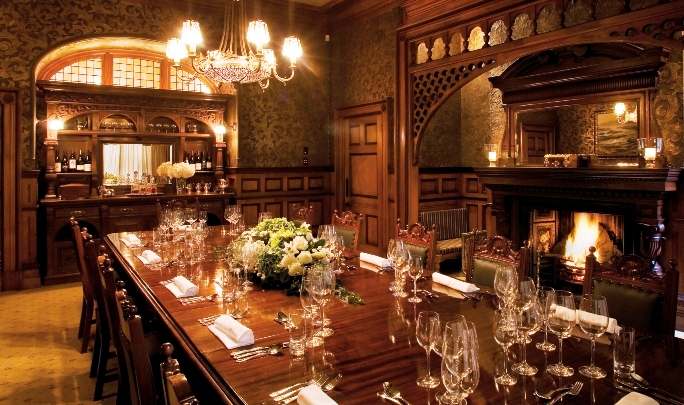Otahuna was designed and built for Sir Robert Heaton Rhodes (1861-1956), a prominent Canterbury lawyer, runholder and politician. Born at Purau on Banks Peninsula, Rhodes attended the University of Oxford and completed his MA in 1887. He returned to New Zealand in 1888, where he was admitted as a barrister and solicitor of the Supreme Court in Christchurch. The early death of his father, in 1884, enabled Rhodes to give up the law and adopt a new career as a farmer and country gentleman. He began to buy farmland near Taitapu, nine miles (approximately 14.5 kilometres) south of Christchurch, and after his marriage in 1891 he commissioned prominent Christchurch architect Frederick Strouts (1834-1919) to design a grand country house. The result, completed in 1895, was a two-and-a-half-storeyed timber house with a slate roof, Otahuna.
Strouts, noted for his design of Ivey Hall at Lincoln College, had designed two earlier houses for the Rhodes family in Christchurch as well Rhodes Memorial Home (1885-1887) built in memory of Rhodes' father. Otahuna is arguably one of Strouts' finest works. Queen Anne in style, the house's notable features include the complex roofline, the tall brick chimneys, the hexagonal corner tower and the sprawling asymmetrical elevations. One of the chimneys bears the date the house was completed and Rhodes' monogram (RHR). The interior of the house is notable for the fine woodwork and for the surviving wallpaper in the entrance hall, living room and dining room.
Rhodes and his wife Jessie (1865-1929) had no children and after his death in 1956 Otahuna was sold. The government acquired the bulk of the estate in 1957 to subdivide into farms for returned servicemen. Otahuna, including its garden was sold to J.E. Boyd, who ran it as a guesthouse. It was then owned by the Christian Brothers, a teaching fellowship who used Otahuna as their national headquarters between 1961 and 1972. For a time the house was occupied by the Otahuna Christian Community, who established a therapeutic community there, before it went back into private ownership in 1975. It remains a family home today.
Otahuna is one of the largest and most complete Queen Anne style houses in New Zealand and is arguably Strouts' most important domestic work. The house has retained its substantial garden and much of the house is in near-original condition. The house and garden stand as a memorial to Rhodes, a noted runholder, politician and philanthropist, who is remembered as the 'outstanding public figure' of twentieth century Canterbury. Otahuna is described by Rhodes' biographer, Geoffrey Rice, as 'his most tangible monument'. More broadly the house and grounds illustrate the late nineteenth and early twentieth century lifestyle of Canterbury's elite.




Location
List Entry Information
Overview
Detailed List Entry
Status
Listed
List Entry Status
Historic Place Category 1
Access
Private/No Public Access
List Number
5327
Date Entered
17th September 1992
Date of Effect
17th September 1992
City/District Council
Selwyn District
Region
Canterbury Region
Extent of List Entry
Extent includes the land described as Lots 1 and 2, DP 301691 (RTs 6976 and 6977), Canterbury Land District and the buildings/structures known as the stables (former) and walled courtyard, hay barn (former), brick appleshed, pig sty (former), game house (former) and stone vegetable shed (former) associated with the Otahuna homestead thereon, and its fittings and fixtures, and the daffodil lawn (Refer to map and photographs below for further information).
Legal description
Lots 1 and 2, DP 301691 (RTs 6976 and 6977), Canterbury Land District
Stay up to date with Heritage this month
